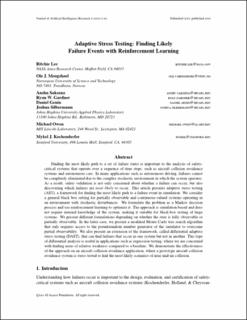| dc.description.abstract | Finding the most likely path to a set of failure states is important to the analysis of safety-critical systems that operate over a sequence of time steps, such as aircraft collision avoidance systems and autonomous cars. In many applications such as autonomous driving, failures cannot be completely eliminated due to the complex stochastic environment in which the system operates. As a result, safety validation is not only concerned about whether a failure can occur, but also discovering which failures are most likely to occur. This article presents adaptive stress testing (AST), a framework for finding the most likely path to a failure event in simulation. We consider a general black box setting for partially observable and continuous-valued systems operating in an environment with stochastic disturbances. We formulate the problem as a Markov decision process and use reinforcement learning to optimize it. The approach is simulation-based and does not require internal knowledge of the system, making it suitable for black-box testing of large systems. We present different formulations depending on whether the state is fully observable or partially observable. In the latter case, we present a modified Monte Carlo tree search algorithm that only requires access to the pseudorandom number generator of the simulator to overcome partial observability. We also present an extension of the framework, called differential adaptive stress testing (DAST), that can find failures that occur in one system but not in another. This type of differential analysis is useful in applications such as regression testing, where we are concerned with finding areas of relative weakness compared to a baseline. We demonstrate the effectiveness of the approach on an aircraft collision avoidance application, where a prototype aircraft collision avoidance system is stress tested to find the most likely scenarios of near mid-air collision. | en_US |
